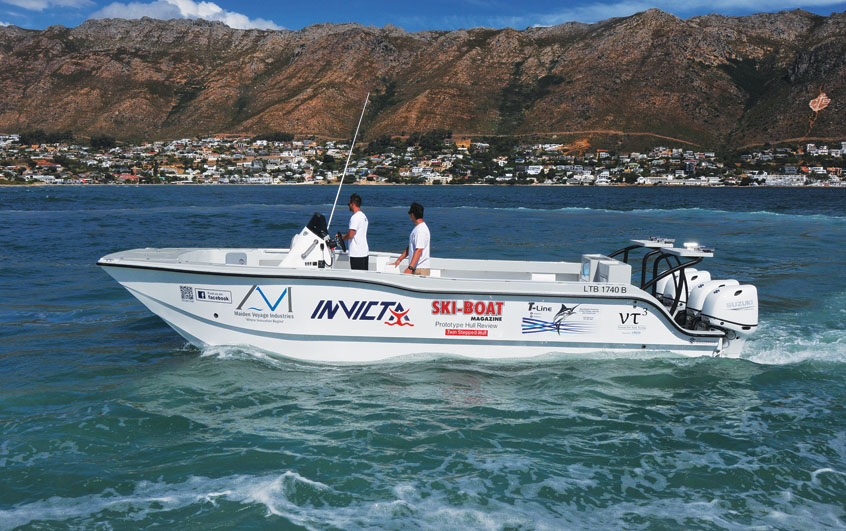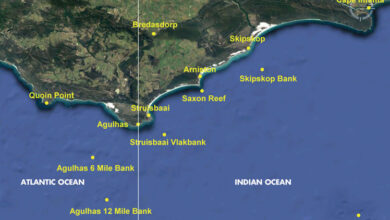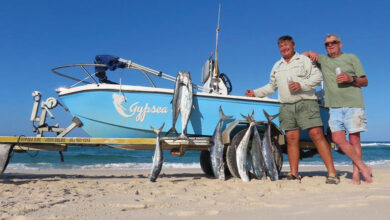AMBITION REALISED
Introducing the Invicta Cat 30 by Maiden Voyage Industries
[Originally published in the May 2022 issue of Ski-Boat magazine]
BY Erwin Bursik
INNOVATING the South African boat building industry — that was the vision of two University of Pretoria Mechanical Engineering graduates who dreamed of designing an offshore sportfishing craft and then going on to build it.
This was no small task for Henry Swanepoel and Ryan Dyer who both detested the “cut and paste” design method of new hull development so common in the marine industry.
They wanted to use their attained theoretical knowledge and computer-aided engineering, along with mastery of the concept of fluid dynamics, to design a hull that optimises the efficiency of a craft’s wetted surface area whilst on the plane.
The two youngsters undertook their initial market research during a visit to the Miami Boat Show, where they came up with the concept of developing a 30ft offshore craft with a stepped hull, powered by four motors.
Ambitious in the extreme, but they achieved it!
The first Invicta Cat prototype in its semi-finished format of a centre console model was launched into False Bay in early March 2022.
 I was privileged to be invited for the launch, and the lure of an opportunity to skipper a craft powered by four 140hp Suzuki outboard motors was impossible to reject. The documentation and photographs I was sent prior to my arrival in Gordon’s Bay had my mind doing summersaults with the thought of what I was going to see and experience when I eventually got to skipper the Invicta Cat and put theory into on-water practice.
I was privileged to be invited for the launch, and the lure of an opportunity to skipper a craft powered by four 140hp Suzuki outboard motors was impossible to reject. The documentation and photographs I was sent prior to my arrival in Gordon’s Bay had my mind doing summersaults with the thought of what I was going to see and experience when I eventually got to skipper the Invicta Cat and put theory into on-water practice.
It was extremely exciting, yet equally daunting as I’d never before skippered a craft with four motors with counter-rotating props and an unconventional hull design. My initial response was “Incredible!” and the longer I spent on the craft with various other skippers and guests, the more I got to appreciate what this craft achieves by way of both performance and comfort.
Within three to four months the final cabin, which I saw in mould format, would have been fitted and the fully completed Invicta Cat will be ready for me to finally review and report on in detail.
They say the proof of the pudding is in the eating thereof, and during the inaugural trials off Harbour Island, my “first taste”of the Invicta Cat 30 was unbelievable.

DESIGN OVERVIEW
The Invicta Cat 30 is a custom-built 30ft power catamaran with a high-performance hull featuring two transverse steps, allowing for passive air ventilation, which decreases wetted surface area and can increase fuel efficiency by 10–15% when planing.
The prototype vessel is designed for sportfishing with a walk-around pilothouse featuring a flybridge and dual helm station. It is specifically designed to withstand the harsh sea conditions fishermen encounter in and around the Cape of Storms.
Once the detailed hydrodynamic design specifications of the hull were accepted, a computer-aided design (CAD) model was generated for the hull. The model is parameterised to minimise the effect of any possible downstream design iterations. An isometric view of the CAD model of the Invicta hull design can be seen in the illustration on the right.
To test, iterate and optimise vessel performance and stability, Maiden Voyage Industries uses specialised virtual tow tank testing. This virtual tow tank testing provides both quantitative and qualitative results, which can be used to predict if the craft performs according to the hydrodynamic design specifications.
Ryan Dyer, who was initially involved with developing in-house hydrodynamic design programs for the unconventional hull design, now manages the virtual tow tank testing of Maiden Voyage Industries hull designs through his company Cauchy Consult.
A LONG LINE OF HA SWANEPOELS
Henry’s interest in fishing and boating started at a very young age thanks to his father, Hendrik Swanepoel, a passionate offshore angler and avid boat owner who was then operating out of the Western and Eastern Cape.
I first met a young Henry Swanepoel 11 years ago at the boat show in Johannesburg when he wanted practical tuition on how to fight marlin using the fighting chair on our boat show stand. He was preparing for a planned marlin fishing trip to Madagascar (see SKI-BOAT March/April 2011). He duly went on to catch his first marlin on that trip.
Boat building seems to be in Henry’s genes, as his grandfather, after departing the Belgian Congo due to political unrest, returned to South Africa and commenced building offshore trawlers in Paarden Eiland. He subsequently established a reputation for being the first boatbuilder to mould and build big trawlers out of glass fibre.
In a fascinating book, H.A. Swanepoel — His Family in Africa by Edward Griffiths, I read a detailed family history of Henry’s forebears. The constant thread was of men searching for opportunities and, by sheer hard work and persistence, achieving success.
The first Hendrik Arnoldus Swanepoel was recruited in Amsterdam by the Dutch East India Company and came to work as a butcher stationed in what was then Cape of Good Hope in 1699.
His sense of adventure and innovation led him trekking inland and farming. These genes were passed on to all the succeeding generations of Hendrik Arnoldus Swanepoels who “trekked” north to South West Africa (Namibia), Rhodesia (Zimbabwe) and ultimately Belgian Congo.
It appears that Henry has inherited those genes from his dad Hendrik who has achieved many goals and accolades in his long and fruitful business career, and is now able to assist and take a huge interest in Henry’s current boat building business.
Keep your eyes peeled for further updates on the Invicta Cat in future issues of SKI-BOAT.






